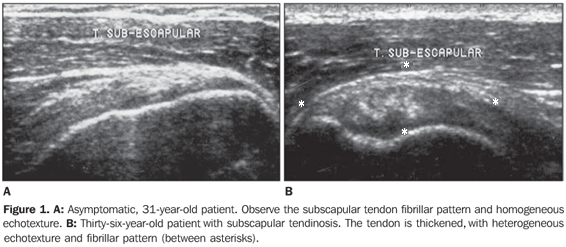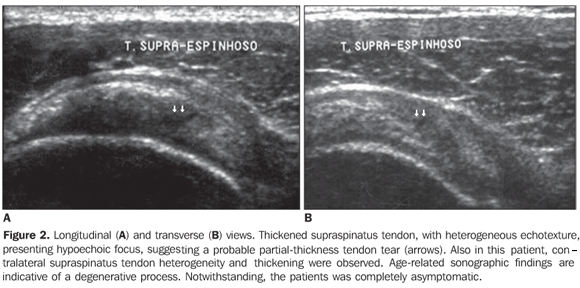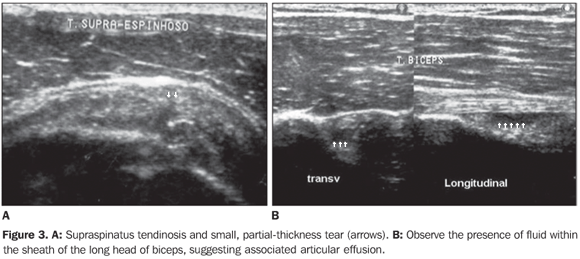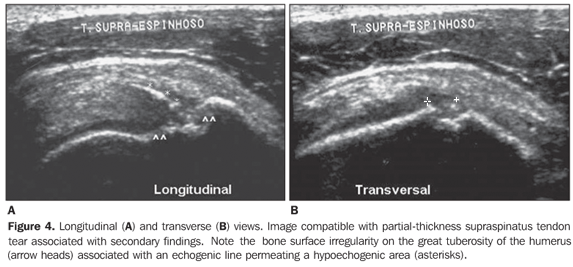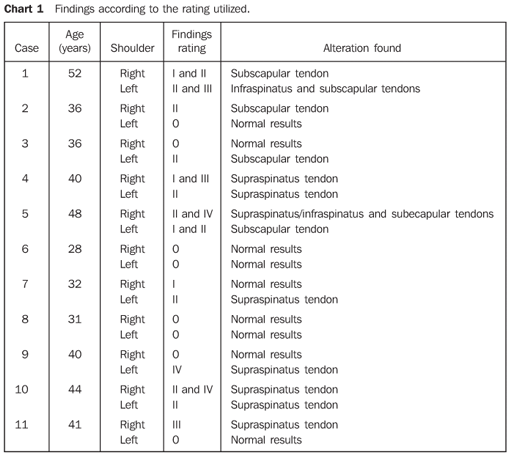Radiologia Brasileira - Publicação Científica Oficial do Colégio Brasileiro de Radiologia
AMB - Associação Médica Brasileira CNA - Comissão Nacional de Acreditação
 Vol. 40 nº 6 - Nov. / Dec. of 2007
Vol. 40 nº 6 - Nov. / Dec. of 2007
|
ORIGINAL ARTICLE
|
|
Sonographic evaluation of the shoulder joint in competitive swimmers |
|
|
Autho(rs): Guilherme Moura da Cunha, Edson Marchiori, Elísio José Ribeiro |
|
|
Keywords: Impingement syndrome, Rotator cuff, Swimmers, Ultrasonography |
|
|
Abstract:
IMD, Resident, Department of Radiology, Hospital Universitário Clementino Fraga Filho (HUCFF) da Universidade Federal do Rio de Janeiro (UFRJ), Rio de Janeiro, RJ, Brazil
INTRODUCTION Shoulder pain is the most frequent complaint among competitive swimmers, in such extent that the designation "swimmer's shoulder" was utilized in 1974 to call a painful syndrome caused repetitive impact on the shoulders of these athletes(1). Shoulder pain hindering swimmers training is reported by 9% to 35% of competitive athletes, whereas 38% to 75% present with previous history of this symptom along their careers(1-3). A study developed with the Canadian Olympic swimming team has concluded that 37% of the athletes' orthopedic complaints are related to shoulders(3). The high number of complaints related to swimmer's shoulders of competitive athletes is due to the fact that their yearly workout involves about 1.32 million strokes, predisposing these athletes to overuse injuries of the shoulder joint(3). Despite the wealth of the literature on the clinical syndrome involving swimmers shoulder pain, there is a scarcity of studies about anatomo-structural assessment in correlation with clinical findings in this population. The present study is aimed at evaluating, by means of ultrasonography, the shoulders of symptomatic or asymptomatic competitive swimmers, quantifying the incidence of rotator cuff lesions found in these athletes by this method.
MATERIALS AND METHODS Eleven competitive swimmers, with ages ranging between 28 and 52 years (mean 32.9 years), eight male and three female, with a minimum five-year training (with a daily mean of > 2500 m undertaken), were selected according to their technical training load, differentiating them from amateur or recreative swimmers found in the general population. The athletes underwent ultrasound examination of the musculoskeletal apparatus, a same protocol being adopted independently from the presence or not of shoulder pain. Later, the sonographic findings were correlated with their ages and the presence or not of symptoms. The examinations were performed in an ultrasound equipment with a linear, 7-11 mHz transducer (Logic 500 - GE Medical Systems) in the period between April and July, 2004 at Clínica de Diagnóstico por Imagem (CDPI), Rio de Janeiro, RJ. The sonographic images included, but were not limited to, longitudinal and transverse views of supraspinatus, infraspinatus, subscapular tendons, and the long head of the biceps tendon, besides the evaluation of the acromioclavicular joint, posterior joint recess, and bursae. The tendons were assessed as regards their diffuse abnormal echogenicity, echotexture and thickness. Possible focal alterations were evaluated as regards echogenicity and localization (bursal surface, articular surface or intrasubstance). Thickened tendons with echogenicity alterations, heterogeneous echotexture and loss of usual fibrillar pattern, were considered as tendinosis(4). Partial-thickness tendon tears were characterized by anechoic or hypoechoic areas, with tendinous fibers discontinuity, evaluated according to their dimensions, site, and presence of associated, and divided into probable partial-thickness tear, or compatible with partial-thickness tear. Hypoechoic tendinous areas only were considered as compatible with tear in the presence of fiber discontinuity and/or associated, secondary findings of tear; otherwise, they were considered as tendinosis. Secondary findings usually associated with tendinous tears and presence of extratendinous findings, like bursitis, acromioclavicular joint alterations, articular effusions and others were evaluated. All of the findings should be confirmed by at least two opposite orthogonal planes. The findings were rated as follows: zero - normal tendons; type I - peritendinous inflammatory lesions(5); type II - thickened tendons with heterogeneous echotexture (tendinosis)(4,5); type III - small, ill-defined, hypoechoic foci, predictive or probably suggestive of tendinosis with small full-thickness tendon tears; type IV - well defined lesions with associated findings compatible with partial- or full-thickness tendon tear(6-8). According to the literature(5,9) pain-related alterations are rated as types I and IV. Tendinosis, included in types II and III, may or not be associated with pain, these tendinous degenerative process being poorly correlated with the clinical condition of the patient. After undergoing ultrasound examinations, these individuals were classified according two criteria: 1) presence of shoulder pain; 2) age-range, based on the literature about prevalence of rotator cuff lesions: individuals with < 40 years of age, or individuals with > 40 years of age(9-11).
RESULTS Sonographic findings Twenty-two shoulders were evaluated with basis on the classification adopted, and the incidence of findings was distributed as follows: type I alterations - four shoulders (18.18%); type II alterations (Figure 1) - 11 shoulders (50%); type III alterations (Figure 2) - three shoulders (13.63%); type IV alterations (Figures 3 and 4) - three shoulders (13.63%).
Amongst the sonographic findings, the most prevalent one was tendinosis. Six of the examined athletes (54.5%) presented with at least one of theirs shoulders with types I and IV alterations directly related to shoulder pain. Three athletes (27.2%) presented with types II and III alterations with a poor clinical significance. In two athletes (18.18%), no alteration was found on their shoulders ultrasound examination. Symptoms In the present study, 63.6% (seven) of the swimmers complained of pain in at least one of their shoulders, frequently in association with the swimming practice. By correlating the data of these individuals with the pain-related findings, the authors could observe that 85.7% of these symptomatic patients presented type I and/or type IV alterations, and 57.1% presented non-rotator-cuff-related inflammatory alterations (bursitis), with overlap between findings in four individuals. Four individuals (36.3%) were asymptomatic, with no complaint of shoulder pain. In this group, three athletes presented only type II and/or type III alterations, and one, presented type IV alteration in one of the shoulders. Ages The division of the individuals into two defined age groups resulted as follows: five athletes (45.4%) with < 40 years, and six (54.5%) with > 40 years. The correlation between this criterion and the sonographic findings demonstrated that 40% of the individuals with < 40 years presented type II alterations, with no sign of tendon tears or even probable tears in this age group. One individual in this age group presented type I alteration. In the group with > 40 years of age, incidence of tendinous alterations (II, III and IV types) was observed in 83.3% of individuals. One hundred percent of cases with tears or even probable tears (III and IV types) were observed in this age range. Therefore, there was a clear correlation between higher ages and the presence of tendon lesions (Chart 1).
DISCUSSION The shoulder pain mechanism in competitive swimmers is multifactorial, and, basically, results from the several forms of impingement of subacromial tissues. The repetitive compression of the supraspinatus tendon and subdeltoid bursa under the coracoacromial arch leads to pain and individual structural alterations(2,12). The tendon affected by traction, impingement and abnormal vascular irrigation progresses with a degenerative process probably resulting in tear. In the bursa, the repetitive impingement may result in inflammatory alterations. Both processes lead to pain as a final result(13,14). Therefore, the prevalence of pain in these athletes is considerably high, ranging from 47% to 73% according reports in the literature(15,16). Similarly to the reviewed literature, the present study has found a 63.6% prevalence of shoulder pain among the participating individuals. Inflammation of the bursa, a well innervated synovial structure, leads to a painful clinical picture. Tuite(12), in a study on magnetic resonance imaging, has reported that, most frequently, lesion of tendinous structures of the rotator cuff are absent in young athletes with shoulder pain. The prevalence of partial-thickness tears seen on ultrasound in the present casuistic (13.63%) was similar to the one reported by Matsen(11), who has found, in studies with cadavers, a prevalence of 13% in the general population. Jacobson et al.(7) have evaluated the ultrasonography accuracy in the detection of partial- and full-thickness tears also evaluated by other authors such as Holsbeeck et al.(6) and Hodler et al.(17). These studies have demonstrated that, specifically for detecting these alterations, ultrasonography is an excellent method, with up to 100% sensitivity for full-thickness tears, and a 92% prospective accuracy for tendinous defects. In the present study, the most prevalent finding was tendinosis (50% of cases), followed by bursitis (18.18%). Jacobson et al.(7), in their study about sonographic findings in rotator cuff, have reported that the differentiation between tendinosis and small partial intrasubstance tear may be difficult. Both present a similar aspect at ultrasound and are part of a same progressive, degenerative process of the tendon. Therefore, due to the literature scarcity and differential diagnosis difficulty, the exact prevalence of tendinosis based on evaluation by ultrasonography in the present study and in the general population is still to be established. Furthermore, this abnormality cannot be arthroscopically identified, and studies in cadavers characterizing this percentage are not available, so it is still more difficult to estimate its exact prevalence. Taking all these aspects into consideration, type II and type III alterations were adopted as an initial phase of the degenerative process for including tendinosis as a finding. So, the results of the present study demonstrated that nine (81.8%) individuals presented some kind of tendon degeneration. These data correspond to the results reported by Neumann et al.(18), who have evaluated rotator cuff of asymptomatic volunteers by means of magnetic resonance imaging, finding similar values. Eighty-nine percent of their patients presented abnormalities compatible with degeneration, and only 2%, abnormalities compatible with partial-thickness tears. This result must be justified by the mean age (26 years) of the individuals included in their study. As regards the presence of shoulder pain, 85.7% of athletes in the present study presented sonographic evidences justifying a painful clinical picture (bursitis or tears). Bursitis was present in 57.1% of these patients, demonstrating that the lesion and pain mechanism observed in swimmers is part of a same physiological process of impingement, and, sometimes, there is an overlap between bursitis and tendon tears. In the present study, tendinosis occurred in 85.7% of symptomatic, and in 50% of asymptomatic individuals. According to Maffulli et al.(5), the tendinosis process is not necessarily symptomatic, and sometimes the patient may progress to an advanced degree of tendinosis in spite of never having experienced any discomfort in the tendon region. Up to the present moment, the reason for the disabling symptoms resulting from tendinosis in some individuals are still to be determined, whereas most of times the process is totally asymptomatic, even progressing to a more advanced degree resulting in tendon tear(5). Notwithstanding, because of the scarcity, in the literature, of extensive studies about tendinosis in the general population, a linear relation between tendinosis and shoulder pain is still to be defined. Therefore the clinical meaning of tendinosis, up to the present moment, is poorly defined. Neumann et al.(18) have observed that 89% of the patients in their study presented abnormalities potentially corresponding to tendinosis/tendon degeneration, and even so were asymptomatic(19). Age, another factor considered in the present study, demonstrated a reasonable correlation with the literature reviewed. In the present casuistic, 100% of the patients with type IV alterations were in the age range above 40 year, in agreement with the literature. However, the analysis of the athletes included in the present casuistic, demonstrated a prevalence of tendon tears similar to the prevalence in the general population, this prevalence being determined by the age of the individuals(20). In the correlation between presence of symptoms and age range, a higher incidence of complaints of pain among the athletes included in the present study was observed as compared with studies evaluating the presence of pain in elite swimmers with a mean age of 19 years. However, if a previous history of shoulder pain during these athletes career is considered, the incidence is similar - about 64% in both groups(21). The present study demonstrated that, despite the high incidence of shoulder pain in swimmers, this seems to be related to non-tendinous inflammatory processes or partial-thickness tears found in the general population. Swimming seems not to increase the incidence of rotator cuff tendinous lesions, even in individuals practicing this activity for long periods of time(20). In this context, the difficult characterization and the low clinical significance of tendinosis, as well as the lack of studies evaluating its incidence in the general population, do not allow to evaluate if competitive swimmers present a more accelerated tendinous degenerative process than the general population. A high prevalence of alterations in the echogenicity and echotexture of subscapular tendons was observed in athletes included in the present study. These were the most frequently affected tendons after supraspinatus tendons. No similar result was found in the literature, considering that, with the known impingement mechanisms supposedly affecting these individuals, the order of tears prevalence involves firstly the supraspinatus tendon, and secondly, the infraspinatus tendon. Even in studies evaluating the posterosuperior impingement, which is the most frequent type of impingement among athletes involved in throwing and swimming, the infraspinatus was the second most frequently involved tendon. The limitations of the present study were firstly related to the small size of the sample; secondly, to the absence of surgical or histopathological confirmation for the imaging findings. Finally, competitive swimmers, despite the higher unnatural demands on their shoulder joints, do not seem to present a higher prevalence of rotator cuff tendon tears / early degeneration as compared with the general population. Most of times, the higher prevalence of shoulder pain in these athletes is a result of the inflammatory process involving the subacromiodeltoid bursa (bursitis) generated by the swimming multifactorial impingement mechanism. The individuals' age among swimmers or even among the general population plays the most significant role as a determining factor of rotator cuff tendon tears.
REFERENCES 1. Koehler SM, Thorson DC. Swimmer's shoulder: targeting treatment. Phys Sportsmed 1996;24:39–50. [ ] 2. Kammer CS, Young CC, Niedfeldt MW. Swimming injuries and illnesses. Phys Sportsmed 1999;27:51–60. [ ] 3. McMaster WC, Troup J. A survey of interfering shoulder pain in United States competitive swimmers. Am J Sports Med 1993;21:67–70. [ ] 4. Connell D, Burke F, Coombes P, et al. Sonographic examination of lateral epicondylitis. AJR Am J Roentgenol 2001;176:777–782. [ ] 5. Maffulli N, Khan KM, Puddu G. Overuse tendon conditions: time to change a confusing terminology. Arthroscopy 1998;14:840–843. [ ] 6. van Holsbeeck MT, Kolowich P, Eyler WR, et al. US depiction of partial-thickness tear of the rotator cuff. Radiology 1995;197:443–446. [ ] 7. Jacobson JA, Lancaster S, Prasad A, van Hols beeck MT, Craig JG, Kolowich P. Full-thickness and partial-thickness supraspinatus tendon tears: value of US signs in diagnosis. Radiology 2004; 230:234–242. [ ] 8. Wohlwend JR, van Holsbeeck M, Craig J, et al. The association between irregular greater tuberosities and rotator cuff tears: a sonographic study. AJR Am J Roentgenol 1998;171:229–233. [ ] 9. Uri DS. MR imaging of shoulder impingement and rotator cuff disease. Radiol Clin North Am 1997;35:77–96. [ ] 10. Kjellin I, Ho CP, Cervilla V, et al. Alterations in the supraspinatus tendon at MR imaging: correlation with histopathologic findings in cadavers. Radiology 1991;181:837–841. [ ] 11. Matsen FA III. Rotator cuff tears. UW Medicine – Orthopaedics and Sports Medicine [On-line]. [Acessado em: 26/7/2004]. Disponível em: http://www.orthop.washington.edu/uw/tablD_3351/Default.aspx [ ] 12. Tuite MJ. MRimaging of sports injuries to the rotator cuff. Magn Reson Imaging Clin N Am 2003;11:207–219. [ ] 13. Brossmann J, Preidler KW, Pedowitz RA, White LM, Trudell D, Resnick D. Shoulder impingement syndrome: influence of shoulder position on rotator cuff impingement – an anatomic study. AJR Am J Roentgenol 1996;167:1511–1515. [ ] 14. Khan KM, Cook JL, Taunton EJ, Bonar F. Overuse tendinosis, not tendinitis. Part 1: a new paradigm for a difficult clinical problem. Phys Sportsmed 2000;28:38–48 [ ] 15. Dandachli W. Swimming shoulder injuries: water workouts are pretty safe. But top-level performers are more vulnerable to certain injuries. Sports Injury Bulletin.com [On-line]. [Acessado em 26/7/2004]. Disponível em: http://www.sportsinjurybulletin.com/archive/swimming-shoulder-injuries.html [ ] 16. Johnson JN, Gauvin J, Fredericson M. Swimming biomechanics and injury prevention. New stroke techniques and medical considerations. Phys Sportsmed 2003;31:41–46. [ ] 17. Hodler J, Fretz CJ, Terrier F, Gerber C. Rotator cuff tears: correlation of sonographic and surgical findings. Radiology 1988;169:791–794. [ ] 18. Neumann CH, Holt RC, Steinbach LS, Jahnke AH Jr, Petersen SA. MR imaging of the shoulder: appearance of the supraspinatus tendon in asymptomatic volunteers. AJR Am J Roentgenol 1992; 158:1281–1287. [ ] 19. H ollister MS, Mack LA, Patten RM, Winter TC 3rd, Matsen FA 3rd, Veith RR. Association of sonographically detected subacromial/subdeltoid bursal effusion and intraarticular fluid with rotator cuff tear. AJR Am J Roentgenol 1995;165: 605–608. [ ] 20. Bak K, Faunl P. Clinical findings in competitive swimmers with shoulder pain. Am J Sports Med 1997;25:254–260. [ ] 21. Cohen M, Abdalla RJ, Ejnisman B, Schubert S, Lopes AD, Mano KS. Incidência de dor no ombro em nadadores brasileiros de elite. Rev Bras Ortop 1998;33:930–932. [ ]
Received February 21, 2006. Accepted after revision April 26, 2007.
* Study developed at Clínica de Diagnóstico por Imagem (CDPI) and Hospital Universitário Clementino Fraga Filho (HUCFF) da Universidade Federal do Rio de Janeiro (UFRJ), Rio de Janeiro, RJ, Brazil. |
|
Av. Paulista, 37 - 7° andar - Conj. 71 - CEP 01311-902 - São Paulo - SP - Brazil - Phone: (11) 3372-4544 - Fax: (11) 3372-4554
